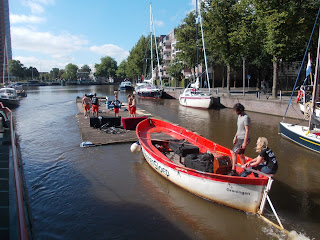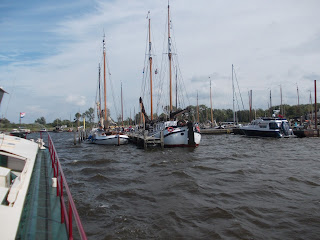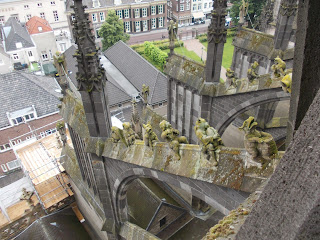So finally, we are
writing our last blog of the year.
It has been a fraught
few months since we last published a blog, hence the rather long
delay in writing this one!
We ended our last blog
at a nice Marrekrite mooring close to a town called Joure.
 |
| Rubbish collection at a FREE mooring place |
From there we spent a
few days in the commercial harbour in Drachten – empty and free
including electricity - while we waited for a day fine enough to take
the wheelhouse roof off to pass under 3 low bridges on the next leg
of our journey.
 |
| Drachten - another free, and empty mooring |
Eventually the day
dawned bright and dry and we cruised up to the first bridge, tied up
to a rather rickety private mooring and lowered the roof. The people
in the house opposite were fascinated and amazed and gave us the
universal thumbs-up gesture.
We spent a couple of
nights in Groningen on a good free mooring on the canal to the south
east approach.
 |
| Groningen railway station - magnificent |
We had fun going
through the town with all the lift bridges and had to wait ages at
one of them, while a long museumbrug ‘raft’ powered by an
outboard at each end came through: the front outboard acting as their
‘bow thruster’!
 |
| Strange craft |
We headed north through
the Hoge Zuidval up as far as the Lauwwersoog inland lake, which is
about as far north you can get in Holland and had a windy lunch stop
on the edge of a jachthaven there. We decided, though, not to spend
the night in this extremely uncomfortable spot, cost notwithstanding,
and found a good sheltered mooring on an island further south.
 |
| Lauwwersoog - windy lunch spot |
At Leeuwarden we had
been told by our friends George and Suzanna Snijder that we would be
able to use the historic harbour and to contact Robert the
harbourmaster for permission. A great mooring for €5 a night and
the young lady in the barge behind us let us plug into her
electricity supply after some sweet talk by Alex.
 |
| Leeuwarden bridge and leaning tower |
We stayed for 4 nights!
We took the train back to Vreeswijk to pick up the car which we
dropped off at SRF in Harlingen. Leeuwarden is a nice town with
interesting things to do and see. On one of our days there the town
was holding a festival all along the side of the canal with shows and
live performances everywhere. And great fun!
 |
| Outdoor performance artistes at the Festival - brilliant! |
At last the weather had
cheered up and we found an idyllic mooring in the country for our
last night before heading to SRF for the lift out.
 |
| Harlingen tall ships |
The lift went without a
hitch and after jet washing her hull RICCALL was lowered gently onto
her supports for the rest of the work to begin.
 |
| Gentle manoeuvring |
We had decided, among
other things, that we ought to get the TRIVW certification for
RICCALL because although this is generally only required for boats
over 20m, there is a caveat that shorter boats whose overall
dimensions (in metres) when multiplied together come to over 100,
would also need the TRIVW. Ours comes to 126 so even though it’s
probably unlikely that we would ever be questioned about it, we
decided to get the certificate, because at this stage older ships
have less onerous demands on them provided the certificate is gained
before the end of 2018. Thereafter, all ships requiring
certification will have to comply fully, so if RICCALL was found to
need the TRIVW after 2019 she wouldn’t be able to comply and would
probably have to be scrapped.
We contacted Peter
Voerman who can carry out the necessary surveys and issue a TRIVW
certificate.
We also asked SRF for a
quote for modifying the stern to reduce our severe prop walk and also
to make the rudder a bit more efficient.
The quote for this work
seemed acceptable, and involved cutting out the vertical support for
the skeg, reinforcing said skeg with horizontal bars on either side,
creating a quarter tunnel over the propeller and adding a bit to the
front edge of the rudder.
While all that was
going on, Peter Voerman turned up to do the hull survey and
certification.
He found a couple of
rivets that needed welding and said that the turn of the bilge on the
port side would need to be overplated at some point in the next 3 to
4 years. We decided to have it done there and then as we had
confidence in SRF and then wouldn’t have to worry about it for the
rest of our lives!
Peter mentioned a
couple of other minor things to do on the hull and a few acquisitions
to allow him to give us the TRIVW (reflective life-ring, 150mm high
ENI number installed on the rear of the wheelhouse, 3 x 6kg fire
extinguishers, ‘no flame’ signs near fuel fillers, ‘wear ear
protectors’ in engine room etc etc – so nothing too onerous.
Hopefully then, when we have sent him the photographic evidence of
all those things, we will have our TRIVW certification. Whoopee!
Over the next couple
for weeks SRF carried out all the work over the prop and on the
rudder while Alex and Louise stripped off the paint on the saloon
roof and repainted it all with two pack epoxy. Alex also replaced
the water pump on the engine and repacked the stern gland packing
(SRF refurbished the prop shaft bearings as well.)
 |
| What SRF did |
We joined our chums,
Paul and Diane, for 3 nights in an Airbnb flat in Harlingen, to give
us some respite from boat-yard living (good suggestion P and D) and
entertained Mary and Martin and George and Suzannah for supper on
board one evening.
SRF painted the
underside and we did from the waterline up to deck level. One of the
other joys of the strap lift-out came when RICCALL was put back in
the straps, lifted and the places that had been on the supports could
be painted as well before she went back in the water.
Now we had the return
trip to our mooring in Bruges to tackle and complete, within a couple
of weeks or so.
This is so unlike our
usual style, as it meant long days and very brief stops for lunch, if
any.
As we reversed out of
the straps at SRF Alex immediately noticed that the prop walk had all
but disappeared but in due course when we got into the shallower
canals we discovered the downsides of the prop tunnel. Basically, in
shallow water, the prop was being starved of water creating
cavitation and the need for many more revs from the engine to create
the same stopping, starting and turning effects compared to before
the tunnel was fitted.
At one particularly
sharp bend we ended up on the ‘wrong’ side of the canal at the
bottom of somebody’s garden because we just couldn’t make the
turn. The houseowner who was in the garden doing a bit of weeding,
was somewhat surprised but we explained that we had just had work
done and it was taking some getting used to the change!
At
another point we accidentally missed a sign marking a village canal
bypass which had been made, and found ourselves going right through
the middle of the village. A sign indicated we were too big to pass
and we were given conflicting advice as to whether we could get
through or not. Finally a woman barge owner came out to us and said
yes we definitely could, but the bridge keeper would accompany us.
So, very, very slowly with about a foot clearance on either side, we
made our way along the sinuous canal through the village with the
bridge keeper giving us encouragement and advice. We ended up with a
bit of vegetation on the decks but avoided contact all the way
through. A bit tense, with the mods to the steering to cope with.
 |
| A bit tight through Warga! |
Then we were back on
familiar territory, travelling back through Ozzenzijl and Blokzijl
and then another night on Eekt Island and on round the back of
Flevoland Island, eventually through the southern end of the
Markemeer and into Muiden. After another long day we moored at the
lock in Vreeswijk.
 |
| Sailing tjalks |
We decided to give the
Biesbosch another chance on our route south and, armed with a chart
the rescue police had given us 8 years ago, an up to date chart of
the area AND our PC Navigo we set off on the prescribed route,
checking charts and depth readings as we went. All went well for the
first hour then Woomph! we went aground. Fortunately we were going
very slowly so were able to reverse off and try a different course
further towards where we hoped the deeper channel was, but no,
aground again. So Alex said ‘Right, that’s it: we go right back
to where we started and take the longer route which we know is OK
because we did it 8 years ago’. One of the beauties of PC Navigo
is that it shows you where you have been as well as where to go, so
we were able to retrace our route along exactly the same track
as we had used coming in. Even so, we touched bottom a couple of
times on the way back (maybe the very small tide was on the way out!)
but got over no trouble.
 |
| A peaceful mooring - the night before we went aground!! |
So then we were into
the Volkerak and moored for the night at Steenbergsche Vliet, on a
‘no mooring’ sign, but who cares? Just Antwerp and the Scheldt
River to contend with now before an easy trip along the Ghent bypass
canal and on into Flandriahaven in Bruges.
Antwerp docks are
amazing but we had the usual tense wait with another 9 ships at the
Royersluis before getting out onto a choppy Sea Scheldt.
We overnighted at
Dendermonde where the lock keeper again gave us the incorrect time to
leave the following day! but we sussed it out ourslves with the help
of Dick and Lynne on SUZANNA who were moored behind us and were going
to be travelling with us the next day.
However, we were
informed by the lockkeeper when we got to the lock that the river
upstream had been ‘closed’ for dredging and we would have to wait
for another hour or so. This meant that when it finally reopened
there were about 12 barges queued up also trying to go upriver, so
one by one we had to let them pass us as we all headed for Ghent.
 |
| The que;u;e behind us up the Scheldt! |
Once arrived at Bruges,
harbourmaster Patrick tried to moor us at the very end of the
moorings close to where we had been last winter but this time
alonside the quay. Not enough depth! So we ended up swapping places
with Laura Marie - a much shallower-draughted boat - and mooring
outside Anthonia. A nice spot and Jeremy and Carol are lovely
neighbours.
So what did we do in
2016? 1691 Kilometres 101 locks 199 bridges









































